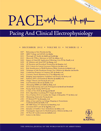Permanent Pacing in Patients with Chagas' Disease
Abstract
Background :Chagas' disease is an endemic disease in most Latin American countries. The cardiomyopathy associated with this condition often requires permanent pacing due to bradycardia. The aim of this study was to compare the indications for pacemaker implantation, intraoperative measurements, and long-term follow-up of patients with Chagas' cardiomyopathy (ChCM) and ischemic cardiomyopathy (ICM) referred for pacemaker implantation.
Methods : Retrospective study including consecutive patients with ChCM (Group 1) and ICM (Group 2), who underwent pacemaker implantation in a single center.
Results : We analyzed 360 patients. Patients in Group 1 were younger (66.29 ± 7.01 vs 75.3 ± 7.11 years; P = 0.0001) and more often male (72% vs 60%; P = 0.05). Sinus node dysfunction (SND) was more prevalent in Group 1 (70% vs 52%; P = 0.03). Atrioventricular block was less prevalent in Group 1 (30% vs 48%; P = 0.04). No significant differences were found with respect to left ventricular ejection fraction (54.2 ± 9.1 vs 53.4 ± 8.2%; P = NS) and baseline QRS duration (119 ± 34 vs 108 ± 29 ms; P = NS). Right bundle branch block was more frequent in Group 1 (44% vs 12%; P = 0.0001), and left bundle branch block in Group 2 (6% vs 22%; P = 0.0001). Implantation time was longer in Group 1 (39 ± 19 vs 29 ± 13 minutes; P = 0.001) and was with higher atrial and ventricular pacing thresholds (1.4 ± 0.8 vs 1.0 ± 0.5 V; P = 0.001 and 1.2 ± 0.8 vs 0.6 ± 0.8 V; P = 0.001, respectively). During a follow-up of 42.8 ± 13.6 months, Group 1 had a higher incidence of new atrial fibrillation (34% vs 25.5%; P = 0.001), and there was a nonsignificant trend toward more displacements of the ventricular lead (6% vs 3.5%; P = 0.3). There were no deaths during the follow-up.
Conclusions : ChCM patients receiving pacemakers are younger and more frequently have SND compared to those with ICM. Pacemaker implant is longer in patients with ChCM disease and is with higher pacing thresholds. The incidence of new atrial fibrillation during the follow-up is significantly higher in patients with ChCM. (PACE 2012;35:1494-1497)




